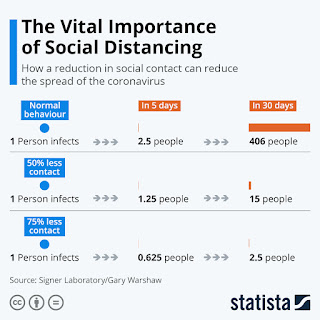Introduction
and Definition
Social distancing is a set of
measures taken to prevent spread of contagious diseases by limiting the number
of times people come in contact with each other and by maintaining a physical
distance between people of at least 2 meters or 6 feet.
The Centres for Disease Control
and Prevention (CDC) have defined Social Distancing as a set of “methods for
reducing frequency and closeness of contact between people in order to decrease
the risk of transmission of disease”. During the 2019–2020 coronavirus
pandemic, the CDC revised the definition of social distancing as
"remaining out of congregrate settings, avoiding mass gatherings, and
maintaining distance (approximately six feet or two meters) from others when
possible.
During
the coronavirus pandemic the WHO recommended the preference to “Physical” in
place of “Social” as because it is the physical distancing which prevents the
transmission; people can and must remain connected socially using various technology.
 |
| Figure 1 depicting social distancing |
History
Social distancing has proved
effective in the past for many pandemics like polio epidemic in New York in
1916, Influenza in 1918, SARS in 2003 and now Coronavirus disease in December 2019
(CoVID 19).
Covid-19 started in Wuhan China
in December 2019 and has spread across the entire world affecting more than
2,397,000 people and causing more than 162,000 deaths as of 22/04/2020.
Measures
Avoiding close contacts and
maintaining a distance of at least 2 meters or 6 feet from one another is the
best way to prevent transmission and delaying the spread of the disease. Avoiding hugs and handshaking; instead use
other ways of greetings like ‘Namaste’.
1] Travel restrictions can delay the transmission from one place to
another and also from person to person .
2] Workplace and Schools closure can help in avoiding people coming in
close contact which delays transmission. Wherever possible it is recommended to
work from home and for children home tasks may be given during the time of
closure.
3] Cancelling mass gatherings like sports, musical events, pubs,
cinemas, swimming etc.
4] Self-Isolation
of
people with symptoms.
5] Other
measures
like use of PPE’s like face mask, good cough etiquettes, good hand hygiene etc
are equally important in delaying the transmission.
How
does social distancing help in delaying disease transmission?
Coronavirus infection spreads
mostly by droplets (coughing and sneezing), and by direct physical contacts
(touching a patient), indirect physical contacts (touching a contaminated surface); although airborne
transmission cannot be ruled out as of now.
Figure 2 and 3 shows how social distancing can significantly reduce the
number of infected cases after few weeks of occurrence of the disease
 |
| Figure 2 (Source: Google Images) |
 |
| Figure 3 (Source: Google Images) |
Figure 4 illustrates the
contagiousness of various diseases as per WHO which is self explanatory.
 |
| Figure 4 (Source: Google Images) |
Figure 5 illustrates the
comparision between seasonal flu and COVID-19 which is self explanatory.
 |
| Figure 5 : Comparison between seasonal flu and COVID 19 |
Social distancing helps to
flatten the epidemic curve which gives time for health sector to prepare for
increasing load. Figure 6 depicts the epidemic curve with and without social
distancing.
 |
| Figure 6: Flattening the epidemic curve |
Drawbacks
of social distancing:
Loneliness, depression, increased
domestic violence and suicidal rates, loss of jobs, reduced human activity
leading to economic shutdown are some of the drawbacks that the social
distancing can have. The countries and governments weigh the benefits and
disadvantages of social distancing depending on their current situation and
pass orders accordingly.
About the author: Dr. Sarat Kumar Naidu (MBBS, DNB(EM), MRCEM) currently works as a Senior Clinical Fellow at William Harvey University Hospital, United Kingdom. He can be reached at saratnaidu@gmail.com.
Comments
Post a Comment